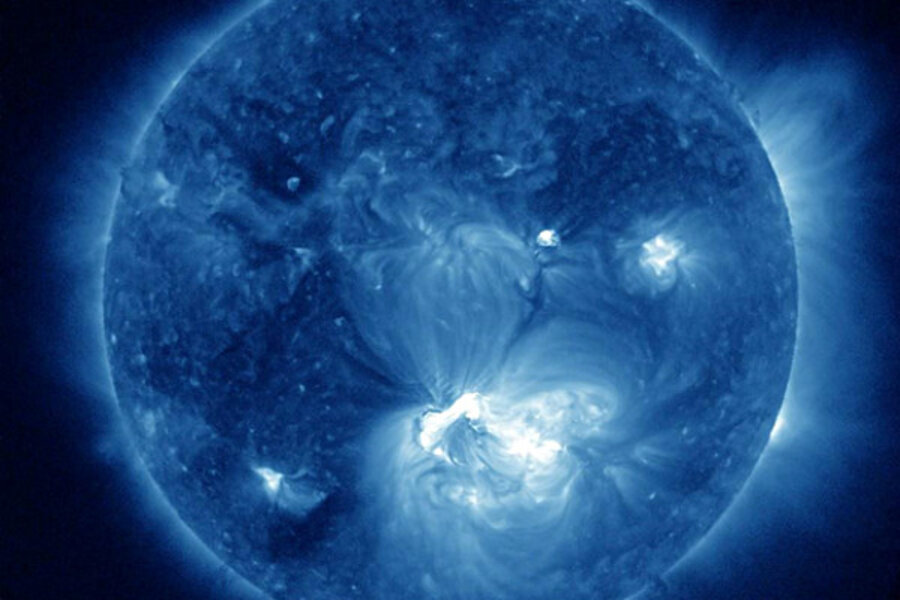Huge solar eruption could make for dazzling northern lights
Loading...
A massive solar eruption may trigger an exceptional weekend northern lights display, perhaps bringing the phenomenon into view as far south as California and Alabama, a NASA scientist says.
The sun unleashed an X-class solar flare — the most powerful type — at 12:52 p.m. EDT (1652 GMT) on Thursday (July 12). The storm also triggered a huge eruption of solar plasma known as a coronal mass ejection, or CME, which is now streaking directly toward Earth at roughly 3 million mph (5 million kph).
The CME is expected to hit our planet at 6:20 a.m. EDT (1020 GMT) Saturday (July 14), plus or minus seven hours, according to researchers with the Space Weather Lab at NASA's Goddard Space Flight Center in Greenbelt, Md.
Thursday's solar outburst officially rated as an X1.4-class flare, making it the strongest sun storm of the summer so far. The flare and CME erupted from a massive sunspot known as AR1520, which scientists say may be up to 186,000 miles (300,000 kilometers) long. [Photos: Solar Flares From Giant Sunspot AR1520]
The CME's arrival at Earth will likely spawn moderate to severe geomagnetic storms, which may cause temporary disruptions to GPS signals, radio communications and power grids, scientists said.
Geomagnetic storms often generate dramatic aurora displays, which are also known as the northern and southern lights. So skywatchers around the world are likely in for a treat this weekend.
The CME "could produce aurora as far south as northern California and Alabama," C. Alex Young, a solar astrophysicist at NASA Goddard, told SPACE.com in an email update. "This would be into central UK and Europe or southern New Zealand."
"It could promise to be a great show of aurora," Young added. "I am hoping for some in Maryland."
Auroras result when charged particles from the sun collide with molecules high up in Earth's atmosphere, generating a glow. The northern and southern lights are usually restricted to high latitutes because Earth's magnetic field lines tend to funnel these particles over the planet's poles.
After remaining surprisingly quiet from 2005 through 2010, our star woke up last year. It has remained active in 2012, spouting off numerous CMEs and powerful solar flares, including an X5.4-class eruption in March.
Such outbursts are likely to continue over the next year or so. Solar activity waxes and wanes on an 11-year cycle, and scientists think the current one — known as Solar Cycle 24 — will peak in 2013.
We should expect more action from sunspot AR1520 for the next week, said Joe Kunches of the National Oceanic and Atmospheric Administration's Space Weather Prediction Center in Colorado. The sunspot region is currently facing Earth, sitting near the center of the sun's southern hemisphere.
"It's still big. It's right down Main Street," Kunches told SPACE.com. "It's in an absolutely prime spot."
Editor's note: If you snap a photo of sunspot AR1520 or any amazing northern lights photos and you'd like to share them for a possible story or image gallery, please send images and comments to managing editor Tariq Malik at tmalik@space.com.
SPACE.com Managing Editor Tariq Malik (@tariqjmalik) contributed to this story. Follow SPACE.com senior writer Mike Wall on Twitter@michaeldwall or SPACE.com @Spacedotcom. We're also on Facebook and Google+.
- The Sun's Wrath: Worst Solar Storms in History
- Anatomy of Sun Storms & Solar Flares (Infographic)
- Amazing Northern Lights Pictures from June 2012
Copyright 2012 SPACE.com, a TechMediaNetwork company. All rights reserved. This material may not be published, broadcast, rewritten or redistributed.





